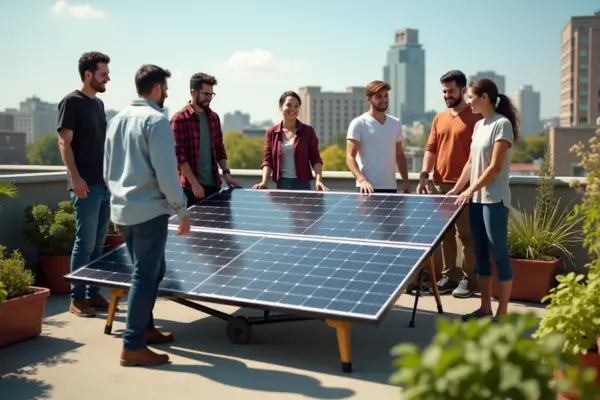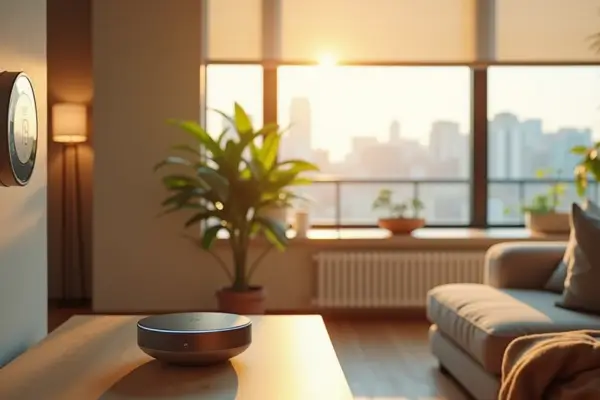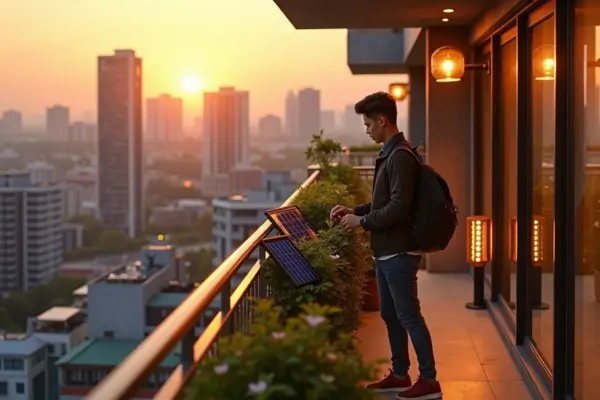Introduction
Urban permaculture is a sustainable design philosophy that transforms city spaces—balconies, rooftops, and small yards—into thriving, self-sufficient ecosystems. By mimicking nature’s efficiency, it helps urban dwellers grow food, conserve water, and reduce waste—all while lowering their carbon footprint. But for renters, embracing this lifestyle comes with unique challenges: strict leases, limited space, and the inability to make permanent modifications.
One of the biggest hurdles? Access to renewable energy. Many eco-conscious renters assume solar power is off-limits because they can’t install rooftop panels. However, innovative, renter-friendly solar solutions—like portable panels, balcony kits, and community solar programs—are making it possible to harness the sun’s energy without needing to own a home.
This article explores how urban renters can integrate solar panels into their permaculture setups, from negotiating with landlords to choosing the right temporary systems. Whether you’re in a tiny apartment or a shared rental, you’ll discover practical ways to reduce your reliance on the grid and live more sustainably—one sun-powered step at a time.
Ready to turn your rental into an eco-haven? Let’s dive in.
1. Understanding Urban Permaculture and Renewable Energy
What Is Urban Permaculture?
Urban permaculture is the practice of designing city living spaces to work with nature rather than against it. Unlike traditional gardening, permaculture focuses on creating closed-loop systems—where waste becomes resources, water is conserved, and food is grown sustainably—even in small apartments or shared urban spaces. Think balcony herb gardens fed by rainwater, compost systems that reduce kitchen waste, or vertical planters that maximize limited square footage.
At its core, urban permaculture is about regenerative living, making cities more resilient while reducing dependence on unsustainable systems.
Why Renewable Energy (Especially Solar) Belongs in Urban Permaculture
Permaculture isn’t just about growing food—it’s about energy independence. Renewable energy, particularly solar power, fits perfectly into this philosophy because:
- It’s decentralized: You don’t need a power plant; the sun is your fuel source.
- It reduces reliance on fossil fuels: Even small solar setups cut down your carbon footprint.
- It pairs with other permaculture systems: Solar can power irrigation pumps, indoor grow lights, or composting tools.
For urban dwellers, solar energy can transform a passive rental into an active, eco-friendly hub—without needing to own property.
Why Renters Should Still Consider Solar (Yes, Really!)
Many renters assume solar panels are only for homeowners, but that’s no longer true. Thanks to portable, non-permanent solar solutions, renters can still benefit from clean energy. Here’s why it’s worth exploring:
✔ Lower electricity bills – Solar chargers and small panels can offset energy costs.
✔ Emergency resilience – Portable solar generators keep lights on during outages.
✔ Landlord-friendly options – No drilling or wiring required with modern plug-and-play kits.
✔ Future-proofing habits – Learning solar basics now prepares you for greener living wherever you move next.
Even if you can’t install a full rooftop system, small-scale solar is a game-changer for urban permaculture enthusiasts. Up next, we’ll dive into the best solar options for renters!
Next section preview: “2. Solar Panel Options for Renters” – Discover portable panels, balcony kits, and creative ways to harness solar energy without permanent changes.
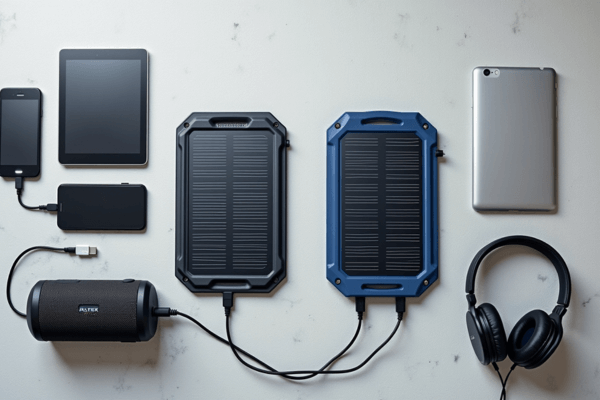
2. Solar Panel Options for Renters: Flexible & Landlord-Friendly Solutions
Living in a rental doesn’t mean you have to miss out on solar power. Today’s market offers innovative, temporary solutions that let renters harness the sun’s energy without permanent modifications. Here are the best options to consider:
Portable & Flexible Solar Solutions
1. Solar Chargers for Small Devices
- Best for: Powering phones, tablets, laptops, and small appliances
- How it works: Compact, lightweight panels (5W-20W) with USB outputs
- Examples:
- Anker 21W Solar Charger (folds for easy storage)
- BigBlue 28W Solar Charger (water-resistant for balcony use)
- Why renters love it: No installation needed—just place near a sunny window or balcony
2. Foldable Solar Panels (100W-200W)
- Best for: Medium energy needs (LED lights, fans, small refrigerators)
- How it works: Lightweight, suitcase-style panels with kickstands
- Examples:
- Jackery SolarSaga 100W (pairs with portable power stations)
- Renogy 100W Eclipse Panel (ultra-thin design)
- Pro tip: Use with a portable battery (like Bluetti or EcoFlow) to store energy for nighttime
3. Solar-Powered Generators
- Best for: Backup power during outages or off-grid living
- How it works: Solar panels charge a battery unit (no gas, silent)
- Examples:
- *Jackery Explorer 300 + SolarSaga 100W* (for basics like lights and WiFi)
- *EcoFlow River 2 + 110W Panel* (faster charging, higher capacity)
- Renter perk: Take it with you when you move!
Temporary & Non-Invasive Installations
1. Balcony Solar Kits (Plug-and-Play)
- Best for: Apartments with sunny balconies or patios
- How it works:
- “Balcony power plants” (like the Balkon Solar 350W Kit) plug into standard outlets
- Energy offsets your usage (no rewiring; some regions require landlord approval)
- Bonus: In the EU, these are legally protected as “tenant electricity” systems
2. Window-Mounted Solar Panels
- Best for: Renters with large, sunny windows
- How it works:
- Thin-film panels (like SUNERGY’s 50W Window Panel) stick via suction cups
- Powers small devices or charges batteries
- Limitation: Less efficient than angled panels but great for low-profile setups
3. Community Solar Programs
- Best for: Renters who can’t install any panels
- How it works:
- Subscribe to a local solar farm (e.g., Arcadia in the U.S.)
- Your utility bill credits you for the energy produced
- Perks:
- Zero installation
- Often cheaper than traditional electricity
Key Considerations for Renters
🔸 Check your lease: Some landlords prohibit exterior modifications—opt for removable options.
🔸 Sunlight access: South-facing windows/balconies yield the best results.
🔸 Local laws: Some areas restrict plug-in solar systems; research first.
Up Next: How to convince your landlord to say “yes” to solar!
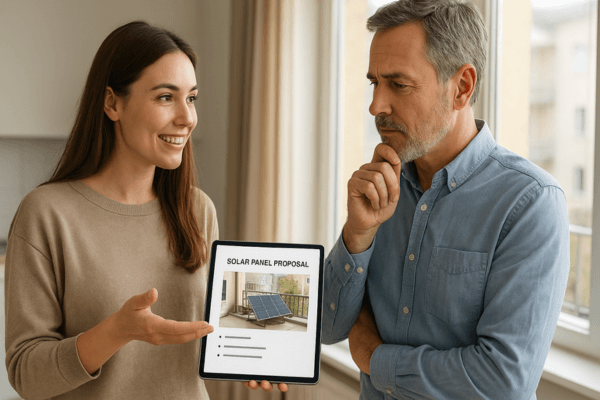
3. Getting Landlord Approval for Solar Panels: A Renter’s Negotiation Guide
Convincing a landlord to allow solar panels might seem daunting, but with the right approach, you can turn “no” into “yes.” Here’s how to frame the conversation for success—focusing on benefits for them and zero-risk solutions for the property.
How to Approach Your Landlord About Solar
1. Lead With Their Interests (Not Just Yours)
Landlords care about property value, costs, and hassle. Open the conversation by addressing these concerns:
“I’ve been researching ways to make the property more energy-efficient, which could actually save you money long-term. Would you be open to a quick discussion about a solar option that requires no permanent changes?”
2. Propose a Trial Period
Ease hesitation by suggesting:
- A 3-month test of removable solar panels
- Full responsibility for installation/removal costs
- A signed agreement that you’ll restore the space to its original condition
3. Bring Documentation
Prepare a one-page summary with:
- Photos of the proposed setup (e.g., balcony panels)
- Links to product specs (highlighting “no-drill” features)
- Local solar incentives they could claim (more below)
Benefits to Highlight for Property Owners
1. Financial Incentives
- Tax credits/deductions: In some areas (e.g., the U.S.), landlords can claim 26-30% solar tax credits—even for tenant-installed systems.
- Increased property value: Homes with solar sell for 4.1% more (National Renewable Energy Lab).
- Lower tenant turnover: Eco-friendly upgrades attract long-term renters willing to pay premium rents (source).
2. No-Cost Upgrades
Emphasize zero-landlord-effort options like:
- Plug-and-play solar (e.g., Balcony Power Plants)
- Community solar subscriptions (no installation required)
3. “Set It and Forget It” Perks
- Reduced building energy costs: If your system offsets common-area electricity (e.g., hallway lights), the landlord saves immediately.
- Future-proofing: As cities push green mandates (e.g., NYC’s Local Law 97), early adopters avoid penalties.
The Compromise: Temporary, Damage-Free Installations
If landlords resist over “property damage,” pivot to these renter-friendly solutions:
1. Suction Cup or Command Strip Panels
- Example: SUNERGY 50W Window Panel (peels off cleanly)
2. Freestanding Solar Setups
- Weighted base panels: No screws needed (e.g., *Renogy 100W + Stand*)
- Solar generators: Simply place on a balcony and plug in (e.g., Jackery setup)
3. Written Agreement Template
Offer to sign a document outlining:
✅ Your responsibility for installation/removal
✅ A guarantee to cover any potential damages (rare with today’s non-invasive tech)
✅ Reversion to original condition upon move-out
Script to Close the Deal
“I completely understand your concerns. What if we start with a small, temporary system for [X months]? I’ll handle everything and share the energy savings data afterward. If you’re not happy, I’ll remove it—no questions asked.”
Pro Tip: If they still refuse, ask if they’d allow indoor solar devices (e.g., solar-powered lights) as a middle ground.
Next Up: “4. Maximizing Solar Energy in Small Urban Spaces”—how to position panels for maximum sun exposure in apartments!
4. Maximizing Solar Energy in Small Urban Spaces
Even in a compact rental, you can optimize solar power by strategic placement, smart integration with permaculture systems, and reliable energy storage. Here’s how to make the most of limited space and sunlight.
Best Placement for Solar Panels in Apartments
1. Balcony/Rail-Mounted Panels
- Optimal Setup: Angled panels (15–30°) facing south (in the Northern Hemisphere) or north (in the Southern Hemisphere).
- Pro Tips:
- Use adjustable brackets (like EcoFlow Solar Tilt Mount) to follow seasonal sun shifts.
- Avoid shading from walls or furniture—keep panels in direct sunlight for at least 4–6 hours/day.
2. Window-Mounted Solar Panels
- Best For: Renters without balcony access.
- Options:
- Thin-film semi-transparent panels (e.g., SolarGaps solar blinds).
- Suction-cup panels (e.g., *SUNERGY 50W stick-on panels*).
- Limitation: Efficiency drops by ~15–25% vs. outdoor panels, but still useful for charging small devices.
3. Rooftop (If Landlord Approves)
- Temporary Solutions:
- Sandbag-mounted panels (no drilling required).
- Portable solar blankets (e.g., PowerFilm 60W).
- Safety First: Check weight limits and wind risks—never place panels unsecured on high floors.
Combining Solar with Other Permaculture Practices
1. Solar-Powered Vertical Gardens
- How It Works: Use a small solar pump (like 12V DC water pump) to automate irrigation for vertical planters.
- Example Setup:
- Solar panel → Battery → Timer → Drip irrigation system.
- Ideal for herb walls or compact hydroponics.
2. Rainwater Harvesting + Solar
- Synergy: Solar energy can power rain barrel pumps for garden watering.
- Renter-Friendly Hack: Use a solar-powered USB pump (e.g., Vivosun 3W pump) to move water from buckets to plants.
3. Solar Composting Tools
- Innovative Gear:
- Solar compost thermometer (monitors heat for efficient breakdown).
- Solar aerators (keeps compost oxygenated without manual turning).
Energy Storage Solutions for Cloudy Days
1. Portable Power Stations
- Best For: Storing solar energy for nighttime/cloudy days.
- Top Picks:
- Jackery Explorer 300 (entry-level, charges phones/laptops).
- EcoFlow River 2 (faster charging, handles small appliances).
2. DIY Battery Banks
- For Tech-Savvy Renters:
- Repurposed electric vehicle (EV) batteries (check local safety laws).
- 12V deep-cycle batteries (paired with a charge controller).
3. Grid-Tied Backup (Where Allowed)
- Community Solar + Storage: Some programs (e.g., Brooklyn Microgrid) let renters “store” excess energy in shared networks.
Quick Checklist for Renters
☑ Sunlight Audit: Track daily sun patterns in your space (apps like SunSurveyor help).
☑ Start Small: A 50W panel + battery can power lights and a fan.
☑ Layer Systems: Pair solar with rainwater or compost for bigger impact.
Next Up: “5. Legal and Financial Considerations”—navigating leases, local laws, and cost breakdowns
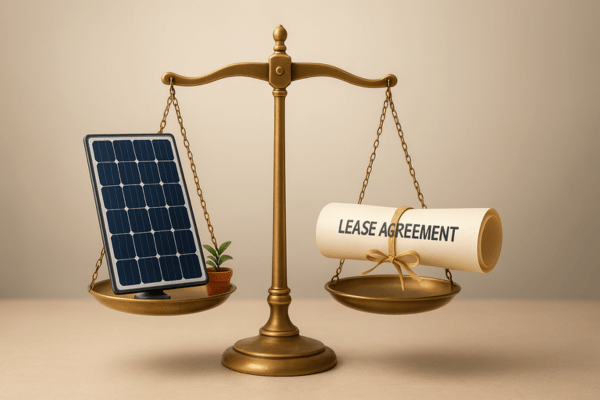
5. Legal and Financial Considerations for Solar in Rentals
Before investing in solar for your rental, it’s crucial to navigate lease agreements, local laws, and costs to avoid fines or disputes. Here’s your practical guide to doing solar the right way as a renter.
Rental Agreements & Solar Panel Policies
What to Check in Your Lease
- Modification Clauses
- Look for terms like “alterations,” “fixtures,” or “permanent installations.”
- Key Question: Does the lease explicitly prohibit solar panels, or is it silent? (Silence = negotiation opportunity!)
- Exterior Space Rules
- Balconies, windows, and rooftops often have stricter rules than interiors.
- Workaround: Use freestanding or temporary setups (e.g., solar generators).
- Subleasing/Submetering Policies
- Some landlords ban submetering (selling excess solar back to the grid).
- Solution: Use stored energy personally or opt for community solar.
How to Amend Your Lease
- Add a solar addendum (sample clauses here). Example:
“Tenant may install removable solar panels under [conditions]. Landlord retains right to inspect and request removal with 30 days’ notice.”
Local Regulations on Renewable Energy
1. Permitting Requirements
- Plug-and-play systems (≤200W): Often exempt (e.g., Germany’s “balcony power plants”).
- Larger systems: May require permits (check DSIRE for U.S. laws).
2. Grid Connection Rules
- For plug-in solar: Some utilities ban “guerilla solar” (e.g., California’s Rule 21).
- Workarounds:
- Use battery storage only (no grid connection).
- Join a community solar program (legal everywhere).
3. Historic Districts & HOAs
- Restrictions: Aesthetic rules may ban visible panels.
- Stealth Solutions:
- Window films (e.g., SolarGaps).
- Indoor panels near sun-facing windows.
Cost vs. Savings: Are Portable Solar Panels Worth It?
Upfront Costs
| System | Price Range | Best For |
| 20W Solar Charger | $30–$80 | Phones, tablets |
| 100W Foldable Panel + Battery | $300–$600 | Lights, fan, laptop |
| Balcony Solar Kit (300W) | $600–$1,200 | Partial home office/kitchen |
Long-Term Savings
- Portable systems: Payback in 2–5 years (if offsetting $20–$50/month in electricity).
- Community solar: Saves 5–15% on bills with $0 installation.
When Solar Isn’t Worth It
- Low sunlight: <3 peak sun hours/day (check Global Solar Atlas).
- Short-term leases: <1 year stays may not justify costs.
Key Questions to Ask Before Buying
- “Does my landlord/lease allow this?” → Get written approval.
- “What’s my daily energy need?” → Add up device wattages.
- “Are there local incentives?” → Some cities offer rebates (e.g., NYC Solar Partnership).
Next Up: “6. Case Studies & Success Stories”—real renters using solar in creative ways!
6. Case Studies & Success Stories: Solar-Powered Urban Renters
These real-world examples prove that renters can harness solar energy—even in tiny apartments or restrictive leases. From Tokyo to Berlin, here’s how urban dwellers are making it work.
1. The Balcony Microgrid (Berlin, Germany)
Renter: Lena, 32, lives in a 50m² apartment with a north-facing balcony.
Challenge: German winters = minimal sunlight. Landlord banned “ugly” panels.
Solution:
✅ Vertical solar setup: Two *100W glass-on-glass panels* mounted on balcony railings (invisible from street view).
✅ Thermal hybrid system: Added a solar-powered radiant heater for winter plants.
✅ Community battery: Shares stored energy with neighbors in exchange for summer surplus.
Result: Cuts 30% of her energy bill and grows herbs year-round.
Key Takeaway: “If you can’t go big, go vertical—and share resources.”
2. Window Solar + Hydroponics (New York, USA)
Renter: Jamal, 28, in a high-rise with no outdoor space.
Challenge: Lease bans “external modifications.”
Solution:
✅ Solar window film: Installed SolarGaps blinds (25W per window).
✅ Closed-loop hydroponics: Powers a small water pump for his indoor lettuce garden.
✅ USB grow lights: Uses excess solar for Aerogarden pods.
Result: $0 monthly electricity for his gardening setup + fresh greens daily.
Key Takeaway: “Windows are untapped real estate for renters.”
3. The Portable Nomad (Barcelona, Spain → Lisbon, Portugal)
Renter: Sofia, 30, digital nomad in co-living spaces.
Challenge: Moving every 3–6 months; needs reliable power.
Solution:
✅ Foldable solar blanket: PowerFilm 60W rolls into her backpack.
✅ Universal battery: Bluetti EB55 works in any country.
✅ Solar backpack: Charges devices on the go with Voltaic 17W panel.
Result: Works remotely from parks/beaches with zero grid reliance.
Key Takeaway: “Solar lets you take your infrastructure with you.”
4. The Guerrilla Solar Collective (Tokyo, Japan)
Group: 5 renters in a shared house with strict landlord rules.
Challenge: No permanent installations allowed.
Solution:
✅ “Solar curtains”: Hung thin-film panels (120W total) behind sheer drapes.
✅ Shared battery bank: Powers their WiFi router and LED lights.
✅ Bicycle generator backup: For cloudy days (yes, really).
Result: 15% lower bills + a resilient microgrid during typhoon outages.
Key Takeaway: “Creativity beats restrictions.”
5. The Community Solar Advocate (Melbourne, Australia)
Renter: Priya, 40, in an apartment with shaded windows.
Challenge: Zero personal solar potential.
Solution:
✅ Joined a solar garden: Subscribed to Melbourne Community Solar.
✅ Organized a building-wide switch: Got 12 units to sign up for bulk discounts.
✅ Negotiated landlord kickbacks: Building owner gets 5% of savings.
Result: 20% cheaper electricity for all tenants + solar-powered common areas.
Key Takeaway: “If you can’t install, organize.”
Global Innovations for Renters
- France: “Sunplug” laws require landlords to allow plug-in solar.
- Netherlands: Solar bike paths feed energy to nearby rentals.
- Brazil: Favelas use recycled car batteries for solar storage.
Next Up: “7. Building a Community Around Urban Solar Permaculture”—how to start a renter’s solar co-op!
7. Building a Community Around Urban Solar Permaculture
Renters often face limitations when going solar alone—but together, they can create collective power (literally and politically). Here’s how to build a community that makes renewable energy accessible to all urban dwellers, regardless of leasing status.
1. Collaborative Energy Projects
Shared Solar Gardens & Co-Ops
What it is: A group of renters pools resources to invest in off-site solar panels (usually on a community building or solar farm).
- How it works:
- Members buy/lease panels in a shared array.
- Energy credits offset individual electricity bills.
- Examples:
- Brooklyn Microgrid (peer-to-peer solar trading).
- Australia’s Community Solar Gardens (renters can buy “plots”).
For Renters:
✔ No need for landlord approval.
✔ Pay-as-you-go options (e.g., $20/month subscriptions).
Start One: Partner with a local solar nonprofit (like Cooperative Energy Futures).
Renter Solar Co-Ops
- Model: 10–50 renters bulk-purchase portable solar kits for discounts.
- Example: Berlin’s “SolarMieten” (solar rental co-op).
2. Local Workshops & Skill-Sharing
How to Organize a Solar-Permaculture Meetup
- Find your tribe: Post in local Facebook groups (e.g., “Urban Gardening [Your City]”).
- Host a “Solar 101 for Renters” workshop: Cover:
- Landlord negotiation scripts.
- Hands-on demos of portable panels.
- Swap gear: Create a tool library for shared solar generators, soil testers, etc.
Real-World Success:
- Portland Renters’ Solar Collective holds monthly “build days” to assemble balcony solar kits.
- Seoul Urban Farmers Network runs solar-powered composting workshops.
3. Advocating for Renter-Friendly Solar Policies
Petitions & City Proposals
Demand these policies:
- “Right to Plug-In Solar” laws (like France’s Sunplug mandate).
- Tax incentives for landlords who allow solar.
- Utility rebates for portable systems.
How to Start:
- Collect data: Survey renters’ solar interest (Google Forms).
- Partner with orgs: Solar United Neighbors helps draft policies.
- Testify at hearings: Bring a portable solar setup to city council meetings.
Wins to Copy:
- Minneapolis passed a rule requiring landlords to consider solar requests.
- Vancouver offers grants for renter-led sustainability projects.
Next Up: *”8. The Future of Solar-Powered Urban Permaculture”*—transparent solar windows, AI energy managers, and more.
8. The Future of Solar-Powered Urban Permaculture
The solar revolution is evolving rapidly—and renters won’t be left behind. From cutting-edge materials to AI-driven energy systems, here’s how urban permaculture and solar power will merge in the near future.
Emerging Tech for Renters
1. Lightweight Solar Fabrics
- Solar curtains & awnings: Thin-film PV woven into textiles (e.g., PowerFabric by Pvilion) can drape over balconies.
- Solar backpacks & clothing: Charge devices on the go (prototypes from Tommy Hilfiger and Voltaic).
- Renter benefit: No installation—just hang and plug in.
2. Transparent Solar Windows
- How it works: Glass with quantum dot coatings (e.g., Ubiquitous Energy) harvests UV/IR light while staying see-through.
- Renter potential:
- Landlords may install these as “green upgrades.”
- DIY stick-on versions (like SolarWindow) could emerge for renters.
3. Modular “Solar Lego” Panels
- Snap-together tiles: Systems like Tesla Solar Roof Tiles (but for renters) could allow removable, interlocking panels.
- Example: SunStyle’s solar shingles (attach with adhesive).
Policy Changes on the Horizon
1. “Right to Solar” Laws for Renters
- Current examples:
- France’s Sunplug: Landlords must allow plug-in solar.
- California’s SB 379: Streamlines balcony solar permits.
- Future trends:
- EU’s “Solar Rooftop Initiative” may mandate solar access for tenants by 2027.
- Renter energy equity bills: Subsidies for low-income portable solar.
2. Landlord Incentives 2.0
- Carbon credit trading: Landlords could earn $$ for tenant solar.
- Lease upgrades: “Green leases” with solar clauses (like Australia’s SolarSaver).
AI & Smart Energy Management
1. AI-Powered Solar Optimizers
- Apps like SolarEdge Home: Use weather forecasts + usage data to:
- Shift energy use to sunniest hours.
- Sell excess power automatically via blockchain (e.g., Brooklyn Microgrid).
2. Plug-and-Play “Solar Assistants”
- Devices like EcoFlow Smart Home Panel:
- Prioritize solar for fridges/WiFi during outages.
- Sync with vertical garden sensors to auto-water at peak solar hours.
3. Community Energy Algorithms
- Platforms like LO3 Energy: Pool renter solar power to:
- Stabilize grids during blackouts.
- Earn collective rebates.
The Bigger Picture: Cities Powered by Renters
1. Microgrids in Apartment Blocks
- Model: Renters + landlords invest in shared rooftop solar + storage.
- Example: Sjölunda Solar Community (Malmö, Sweden) cuts building emissions by 60%.
2. “Solar Equity” Movements
- Demand: Portable solar included in affordable housing programs.
- Precedent: Portland’s Solar Forward donates kits to low-income renters.
3. Urban Resilience Hubs
- Future vision: Libraries/community centers with solar-charging stations for renters during disasters.
What Renters Can Do Now
🔹 Join advocacy groups (e.g., Solar United Neighbors).
🔹 Test new tech: Beta-trial window solar films (sign up at Ubiquitous Energy).
🔹 Prep for policy wins: Draft a “Solar Ready” lease addendum to propose.
The future isn’t waiting—it’s building, one renter at a time.
🌱 The sun doesn’t care if you own or rent—it shines for everyone. 🌞
MMM
Conclusion: Solar-Powered Urban Permaculture Is for Everyone
Living in a rental doesn’t mean you have to sacrifice sustainability. As we’ve explored, urban permaculture and solar energy can thrive even in temporary spaces—with the right strategies, tools, and community support.
Key Takeaways for Renters
✅ Start Small: A $50 solar phone charger or a 100W balcony panel can be your gateway to energy independence.
✅ Negotiate Smart: Use landlord-friendly solutions (suction-cup panels, solar generators) to bypass “no” answers.
✅ Join Forces: Community solar programs and renter co-ops multiply your impact.
✅ Plan for the Future: Advocate for policy changes while experimenting with emerging tech (solar fabrics, AI energy managers).
Your Journey Starts Now
You don’t need a rooftop or a backyard to make a difference. Begin with one solar-powered device, one conversation with your landlord, or one local meetup. Over time, those small steps add up to real energy resilience—and a model for greener cities.
Let’s Keep the Conversation Going!
🌿 Have you tried solar in your rental? Share your wins (or lessons learned) in the comments!
🌿 Stuck on a challenge? Ask our community for advice.
🌿 Want to go deeper? Download our free Renter’s Solar Permaculture Toolkit [insert link].
The sun is your landlord now—and it’s always on your side. ☀️

